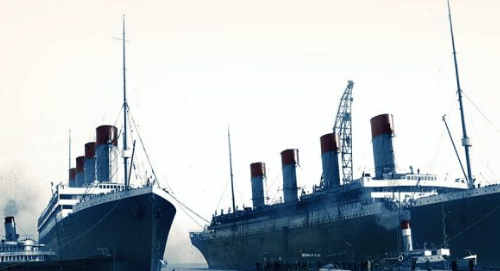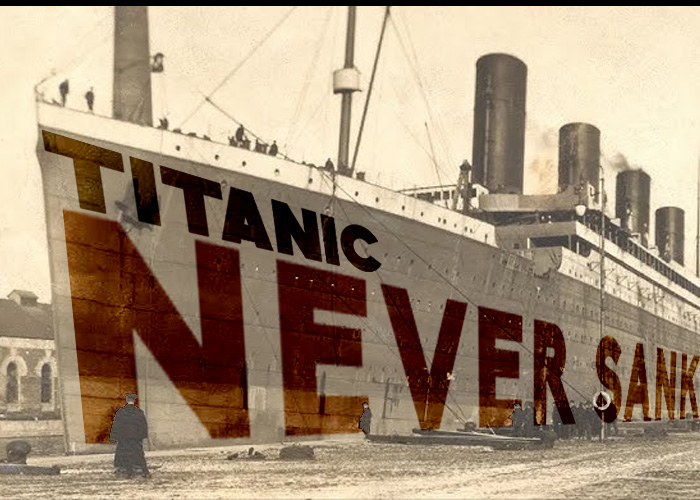The sinking of the RMS Titanic on April 15, 1912, is one of the most tragic and well-known disasters in history. Over 1,500 people lost their lives when the “unsinkable” ship hit an iceberg and sank during its maiden voyage. However, for decades, a controversial theory has persisted: what if the Titanic never sank? What if it was actually its sister ship, the RMS Olympic, that met its fate in the icy waters of the Atlantic? This theory, known as the “Titanic Switch” or “Olympic Switch” conspiracy, suggests that the Titanic and Olympic were swapped as part of an elaborate insurance fraud scheme. In this article, we’ll explore the evidence, timelines, and key players behind this theory, breaking it down in simple terms so everyone can understand.
The Titanic and Its Twin: The RMS Olympic

To understand the conspiracy, we first need to know about the Titanic and its sister ship, the RMS Olympic.
The Olympic-Class Ships
The Titanic and Olympic were part of the Olympic-class ocean liners built by the White Star Line, a British shipping company. The Olympic was launched first, in 1910, followed by the Titanic in 1911. A third ship, the Britannic, was also part of this class but was completed later. The two ships were nearly identical in design, with only minor differences.
The Olympic’s Troubled History
The Olympic had a rocky start. In September 1911, just a few months after its maiden voyage, the Olympic collided with the HMS Hawke, a British warship. The accident caused significant damage to the Olympic, and it had to be repaired. This incident is a key part of the conspiracy theory, as it allegedly left the White Star Line in financial trouble.
The Conspiracy Theory: Switching the Ships
The Titanic conspiracy theory claims that the White Star Line intentionally switched the Titanic and Olympic to commit insurance fraud. Here’s how the theory goes:
- The Olympic’s Damage: After the collision with the HMS Hawke, the Olympic was badly damaged. Repairs were expensive, and the White Star Line was struggling financially.
- Insurance Fraud: To recover their losses, the White Star Line allegedly decided to switch the Olympic with the Titanic. They would deliberately sink the damaged Olympic (disguised as the Titanic) and claim the insurance money.
- The Switch: The theory suggests that the ships were swapped during repairs. The Olympic was repainted and rebranded as the Titanic, while the real Titanic was secretly kept in hiding.
- The Sinking: On April 14, 1912, the disguised Olympic (now posing as the Titanic) hit an iceberg and sank. The White Star Line collected the insurance money and avoided financial ruin.
Evidence Supporting the Conspiracy
Proponents of the Titanic conspiracy theory point to several pieces of evidence to support their claims. While some of this evidence is circumstantial, it has fueled the theory for decades.
1. The Ships’ Similarities
The Titanic and Olympic were nearly identical in design, making it easy to switch them without most people noticing. The conspiracy theorists argue that the White Star Line used this similarity to their advantage.
2. The Olympic’s Damage
After the collision with the HMS Hawke, the Olympic’s hull was severely damaged. Some believe that the damage was so extensive that the ship was no longer seaworthy. Instead of spending money on repairs, the White Star Line allegedly decided to sink the ship and claim the insurance money.
3. The Missing Hull Numbers
When the Titanic’s wreck was discovered in 1985, some researchers claimed that the hull number (401) was missing or altered. This has led to speculation that the wreck might actually be the Olympic.
4. The Lifeboats
The Titanic was famously short on lifeboats, but the Olympic had even fewer. Conspiracy theorists argue that the lifeboats on the “Titanic” (which they believe was actually the Olympic) were mismatched and poorly maintained, suggesting a rushed and secretive operation.
5. The Insurance Policy
The White Star Line had taken out a large insurance policy on the Titanic. If the ship sank, they would receive a significant payout. Some believe this provided a strong financial motive for the alleged switch.
6. The Mysterious Fire
Before the Titanic set sail, there was a coal fire in one of its bunkers. Some theorists claim that the fire was deliberately set to damage the ship and make it easier to sink.
7. The Missing Passengers
A few passengers who had booked tickets for the Titanic’s maiden voyage mysteriously canceled at the last minute. Conspiracy theorists suggest that these individuals may have known about the planned sinking and chose not to board.
Timeline of Key Events
- 1910: The RMS Olympic is launched.
- 1911: The Titanic is launched. In September, the Olympic collides with the HMS Hawke and is damaged.
- 1912:
- March: The Titanic undergoes final preparations for its maiden voyage.
- April 10: The Titanic sets sail from Southampton, England.
- April 14: The Titanic hits an iceberg and begins to sink.
- April 15: The Titanic sinks, resulting in the deaths of over 1,500 people.
- 1985: The wreck of the Titanic is discovered on the ocean floor.
- 1990s–Present: The Titanic conspiracy theory gains popularity, with researchers and theorists examining the evidence.
Debunking the Conspiracy
While the Titanic conspiracy theory is intriguing, many experts and historians have debunked it. Here are some of the main arguments against the theory:
1. The Ships’ Differences
Although the Titanic and Olympic were similar, they had distinct differences. For example, the Titanic had enclosed promenades on its A-deck, while the Olympic did not. These differences would have made it difficult to completely disguise one ship as the other.
2. The Wreck’s Identity
When the Titanic’s wreck was discovered, experts confirmed its identity based on its design and construction. The hull number (401) was found to match the Titanic’s records.
3. The Insurance Payout
While the White Star Line did receive an insurance payout for the Titanic, it was not enough to cover the loss of the ship and the lives lost. The company still faced significant financial difficulties after the disaster.
4. The Human Cost
The idea that the White Star Line would intentionally sink a ship, knowing it would result in the deaths of over 1,500 people, is difficult to believe. The scale of the tragedy makes the conspiracy theory seem unlikely.
Summary and Conclusion
The Titanic conspiracy theory is a fascinating and controversial idea that challenges the official story of the ship’s sinking. While there is some evidence to support the theory, such as the ships’ similarities and the Olympic’s troubled history, most experts agree that the Titanic did indeed sink on that fateful night in 1912. The theory remains popular among conspiracy enthusiasts, but it is important to approach it with a critical mind and consider the facts.
Whether you believe the conspiracy or not, the story of the Titanic continues to captivate people around the world. It serves as a reminder of the dangers of hubris, the fragility of life, and the enduring power of mystery.
Key Points in Brief
- The Theory: The Titanic conspiracy claims that the Titanic and its sister ship, the Olympic, were switched as part of an insurance fraud scheme.
- Evidence: Proponents point to the ships’ similarities, the Olympic’s damage, missing hull numbers, and the insurance policy as proof.
- Debunking: Experts argue that the ships had distinct differences, the wreck’s identity has been confirmed, and the human cost makes the theory unlikely.
- Conclusion: While the conspiracy is intriguing, the evidence suggests that the Titanic did indeed sink in 1912.
Thank you for reading this exploration of the Titanic conspiracy theory. Whether you’re a history buff, a conspiracy enthusiast, or just curious about the Titanic’s story, we hope this article has provided you with a clear and easy-to-understand overview of this fascinating topic.

